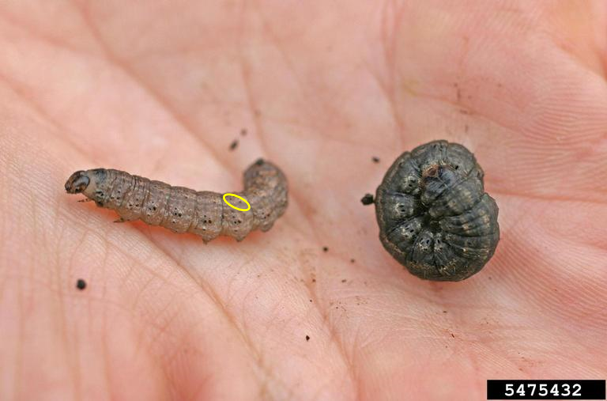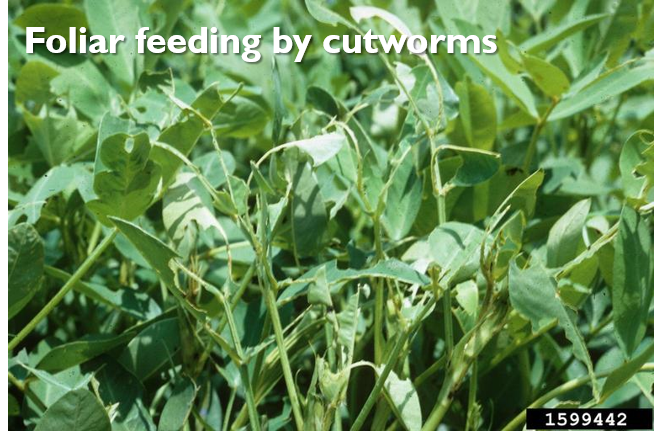IDENTIFICATION
Black cutworm larvae are often described as ‘greasy’. Coloring can vary from light grey to almost black. Look for pairs of black spots that occur along the length of the back. These paired spots are uneven in size but aligned diagonal to each other. Adult moths have a distinctive, singular black triangle on each forewing.

DAMAGE
Cutworms are usually thought of as subterranean pests that feed at or just under the soil surface. Their chewing mouthparts literally ‘cut’ stems of plants as the larvae move about (FIG.2). In fact, 80% of the feeding damage by black cutworm occurs during the final instar of development1.
However, it is important to recognize that foliar feeding occurs when cutworms are small (FIG.1). This is not so much because feeding on leaves affects plant development, but because late-stage larvae are difficult to detect and treat.
Sweet corn is most susceptible at the seedling stage, and feeding becomes more tolerable at 4-lf and beyond. The worst case scenario is when moths lay eggs early and corn is planted late. This means that mid- to late-stage larvae are present just as corn is emerging. Review the degree-day section below for more information.

FIG.1. PHOTO CREDIT: John C. French Sr., Retired, Universities:Auburn, GA, Clemson and U of MO, Bugwood.org, used with permission 
FIG. 2. PHOTO CREDIT: Roger Schmidt University of Wisconsin-Madison, Bugwood.org, used with permission
MONITORING
Pheromone traps and blacklights are used for sampling, although light traps are less effective in the spring. If using plastic bucket traps for BCW, use a white or yellow color rather than green2.
Black cutworm (BCW) is an age-old pest, yet surprisingly little is known about population dynamics. Early arrival of moths is likely a result of spring migrations from lower latitudes, but the male:female ratio of these early flights as well as overwintering capacity in this region is unknown.
DEGREE-DAY MODEL:
The following pest model is provided by USPEST.ORG. Please consult that website for model parameter information, and be aware that degree day models are merely estimates of when pest activity is predicted to occur near Corvallis, OR. There is a narrow window for effectively scouting BCW. For 2021, the model suggests scouting should be done between June 20th and July 7th. Other pest models available at beav.es/4ao

MANAGEMENT
Biological: Natural enemies of this species are abundant. Infection by parasitic wasps and flies can reduce feeding as well as result in eventual death of the cutworms. Entomopathogenic nematodes are known to work on cutworms, but efficacy depends on soil moisture, and reapplication is often required. General predators such as birds, rodents, and ground beetles also feed on cutworm larvae.
Cultural: Many insects feed on weed hosts, and BCW in particular, seem to almost favor them4. Studies are being done to determine optimal timing for weed control near fields. In home gardens, hand-pick and destroy at night or use cutworm collars. Collars (or aluminum foil around stems) need to extend 2″ under the soil surface for full protection.
Chemical: At-plant insecticides are the standard preventative tool for commercial growers, consult the PNW Insect Management Handbook. For homeowners, treated bran and cutworm baits are effective, but caution should be used as they can attract dogs and other animals.